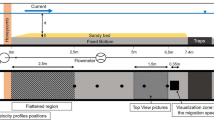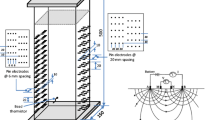Abstract
A large panel of instruments was deployed in the Eastern English Channel to measure the evolution of bedload fluxes during a tidal cycle for two different sites. The first one was characterized by a sandy bed with a low dispersion in size while the other study site implied graded sediments with grain sizes ranging from fine sands to granules. The in situ results obtained were compared with predictions of total bedload fluxes by classical models. A good agreement was found for homogeneous sediments with these formulas. In the case of size heterogeneous sediments, a fractionwise approach, involving a hiding-exposure coefficient and a hindrance factor, provided better predictions of bedload fluxes, but still some discrepancies were noticed. Present results revealed that the consideration of particle shape in formulas through the circularity index enhanced the estimations of bedload transport rates. A new adjustment of Wu et al.’s (J Hydraul Res 38:427–434, 2000) formula was proposed and a very good agreement was obtained between the measured and predicted values.














Similar content being viewed by others
References
Allen JRL (1984) Experiments on the settling, overturning and entrainment of bivalve shells and related models. Sedimentology 31:227–250
Balasubramanian S, Voropayev SI, Fernando HJS (2008) Grain sorting and decay of sand ripples under oscillatory flow and turbulence. J Turbul 9:1
Blanpain O, Bailly du Bois P (2009) Dynamic sediment profile imaging (DySPI): a new field method for the study of dynamic processes at the sediment-water interface. Limnol Oceanogr 7:8–20
Blanpain O (2009) Dynamique sédimentaire multiclasse : de l’étude des processus à la modélisation en Manche. PhD Thesis, Université de Rouen, France.
Brown CB (1950) Sediment transport (chapter 12). In: Rouse H (ed) Engineering hydraulics. Wiley, New York
Chu TD, Jarno-Druaux A, Marin F, Ezersky AB (2012) Particles trajectories and size sorting above a rippled bed under standing water waves. Phys Rev E 85(2 Pt 1):021304
Cotton P, Carter DJT, Allan TD, Challenor PG, Woolf D, Wolf J, Hargreaves JC, Flather RA, Bin L, Holden N, Palmer D (1999) Joint evaluation of remote sensing information for coastal and harbour organisations (JERICHO). British National Space Centre, London, p. 38
Demir T (2000) The influence of particle shape on bedload transport in coarse-bed river channels. Theses, Durham University, Durham
Durafour M, Jarno A, Le Bot S, Blanpain O, Lafite R, Marin F (2013) In-situ study of the influence of size and shape of sediments on bedload transport. In: Seventh conference on coastal dynamics. Arcachon, pp 541–552
Egiazaroff IV (1965) Calculation of non-uniform sediment concentrations. J Hydraul Div, ASCE 91(HY4):225–248
Einstein HA (1942) Formulae for transportation of bed-load. Trans ASCE 107:561–577
Engelund F, Hansen E (1967) A monograph on sediment transport in alluvial streams. Teknisk Forlag, Copenhagen
Gaweesh MTK, Van Rijn LC (1994) Bed-load sampling in sand-bed rivers. J Hydraul Eng 120:1364–1384
Hirano M (1970) On the river bed degradation downstream of a dam and the armoring phenomena. In: Proceedings of the 14th conference on hydraulics
James JWC, Coggan RA, Blyth-Skyrme VJ, Morando A, Birchenough SNR, Bee E, Limpenny DS, Verling E, Vanstaen K, Pearce B, Johnston CM, Rocks KF, Philpott SL, Rees HL (2007) Eastern English Channel marine habitat map. Sci Ser Tech Rep, Cefas Lowestoft 139:191
Janaka GHA, Kumara J, Hayano K, Ogiwara K (2012) Image analysis techniques on evaluation of particle size distribution of gravel. Int J GEOMATE 3(1):290–297
Jouanneau N, Sentchev A, Dumas F (2013) Numerical modelling of circulation and dispersion processes in Boulogne-sur-Mer harbour (Eastern English Channel): sensitivity to physical forcing and harbour design. Ocean Dyn 63:1321–1340
Kirchner JW, Dietrich WE, Iseya F, Ikeda H (1990) The variability of critical shear stress, friction angle, and grain protrusion in water-worked sediments. Sedimentology 37:647–672
Kleinhans MG, Van Rijn LC (2002) Stochastic prediction of sediment transport in sand–gravel bed rivers. J Hydraul Eng 128(4):412–425
Komar PD, Li Z (1986) Pivoting analyses of the selective entrainment of sediments by shape and size with application to gravel threshold. Sedimentology 33:425–436
Lane EW, Carlson EJ (1954) Some observations on the effect of particle shape on the movement of coarse sediments. Trans Am Geophys Union 35:453–462
Larsonneur C, Vaslet D, Auffret JP (1978) Map of the surficial sediments of the English Channel. BRGM, Orléans, France
Lazure P, Dumas F (2008) An external-internal mode coupling for a 3D hydrodynamical model for applications at regional scale (MARS). Adv Water Resour 31:233–250
Li Z, Komar PD (1986) Laboratory measurements of pivoting angles for applications to selective entrainment of gravel in a current. Sedimentology 33:413–423
Mantz PA (1977) Incipient transport of fine grains and flakes by fluids—extended Shields diagram. J Hydraul Div, ASCE 103(HY6):601–615
Meyer-Peter E, Müller R (1948) Formulas for bed-load transport. In: Proceedings of the 2nd Congress rivers, International Association for Hydraulic Research, Rotterdam, pp 39–64
Molinas A, Wu BS (1998) Effect of size gradation on transport of sediment mixtures. J Hydraul Eng 124(8):786–793
Nielsen P (1992) Coastal bottom boundary layers and sediment transport. World Scientific, Hackensack
Paphitis D, Collins MB, Nash LA, Wallbridge S (2002) Settling velocities and entrainment thresholds of biogenic sands (shell fragments) under unidirectional flow. Sedimentology 49:211–225
Parker G, Klingeman PC, McLean DG (1982) Bedload and size distribution in paved gravel–bed streams. J Hydraul Div, ASCE 108(4):544–571
Prager EJ, Southard JB, Vivoni-Gallart ER (1996) Experiments on the entrainment threshold of well-sorted and poorly sorted carbonate sands. Sedimentology 43:33–40
Ribberink JS (1998) Bed-load transport for steady flows and unsteady oscillatory flows. Coast Eng 34:59–82
Rodriguez J, Johansson J, Edeskär T (2012) Particle shape determination by two-dimensional image analysis in geotechnical engineering. In: Proceedings of Nordic Conference on Soil Mechanics and Geotechnical NGM, pp 207–218.
Rousseaux G, Caps H, Wesfreid J-E (2004) Granular size segregation in underwater sand ripples. Eur Phys J Ser E 13:213–219
Schmidt HK, Ergenzinger P (1992) Bedload entrainment travel lengths, step lengths, rest periods—studied with passive (iron, magnetic) and active (radio) tracer techniques. Earth Surf Process Landf 17:147–165
Schmidt HK, Gintz D (1995) Results of bedload tracer experiments in a mountain river. River Geomorphol. In: Hickin EJ (ed) River Morphology. Wiley, Chichester
Shields AF (1936) Application of similarity principles and turbulence research to bed-load movement. Hydrodynamics Laboratory, California Institute of Technology, Publication No. 167, 43.
Smart GM, Jaeggi MNR (1983) Sediment transport on steep slopes. Mitteilungen der Versuchsanstalt für Wasserbau, Hydrologie und Glaziologie, Nr. 64, Zürich
Smith DA, Cheung KF (2003) Settling characteristics of calcareous sand. J Hydraul Eng ASCE 129:479–483
Smith DA, Cheung KF (2004) Initiation of motion of calcareous sand. J Hydraul Eng 130(5):467–472
Soulsby RL (1997) Dynamics of marine sands. Thomas Telford, Springfield 249 pp
Sündermann J (1986) Landolt-Börnstein: numerical data and functional relationships in science and technology, group V, vol 3a. Springer, Berlin
Van Rijn LC (1984) Sediment transport, part I: Bed load transport. ASCE J Hydraul Eng 110:1431–1456
Van Rijn LC, Gaweesh MTK (1992) New total sediment-load sampler. J Hydraul Eng 118:1686–1691
Van Rijn LC (2007) Unified view of sediment transport by currents and waves I: initiation of motion, bed roughness and bedload transport. J Hydraul Eng ASCE 133(6):649–667
Van Rijn LC (2007) Unified view of sediment transport by currents and waves III: graded beds. J Hydraul Eng ASCE 133(7):761–775
Velegrakys AF, Michel D, Collins MB, Lafite R, Oikonomou EK, Dupont JP, Huault MF, Lecouturier M, Salomon JC, Bishop C (1999) Sources, sinks and resuspension of suspended particulate matter in the Eastern English Channel. Cont Shelf Res 19(15–16):1933–1957
Wentworth CK (1922) A scale of grade in class terms for clastic sediments. J Geol 30:377–392
Wilcock P, Crowe J (2003) Surface-based transport model for mixed-size sediment. J Hydraul Eng 129(2):120–1284
Wu W, Wang SSY (2000) Nonuniform sediment transport in alluvial rivers. J Hydraul Res 38(6):427–434
Acknowledgments
The authors express their sincere thanks to the High Normandy region (Scale Research Network) for funding this work and to the University of Utrecht and Ifremer for the loan of the DNS and the DySPI respectively. The authors extend their thanks to Olivier Blanpain for his help on DySPI videos processing and as a member of the team on board of the research vessel Côtes de la Manche (INSU/CNRS), composed also of Michel Lunven, Erwan Legall, Philippe Cugier and Pascal Bailly du Bois, who made the field data collection possible during the campaign.
Author information
Authors and Affiliations
Corresponding author
Rights and permissions
About this article
Cite this article
Durafour, M., Jarno, A., Le Bot, S. et al. Bedload transport for heterogeneous sediments. Environ Fluid Mech 15, 731–751 (2015). https://doi.org/10.1007/s10652-014-9380-1
Received:
Accepted:
Published:
Issue Date:
DOI: https://doi.org/10.1007/s10652-014-9380-1




